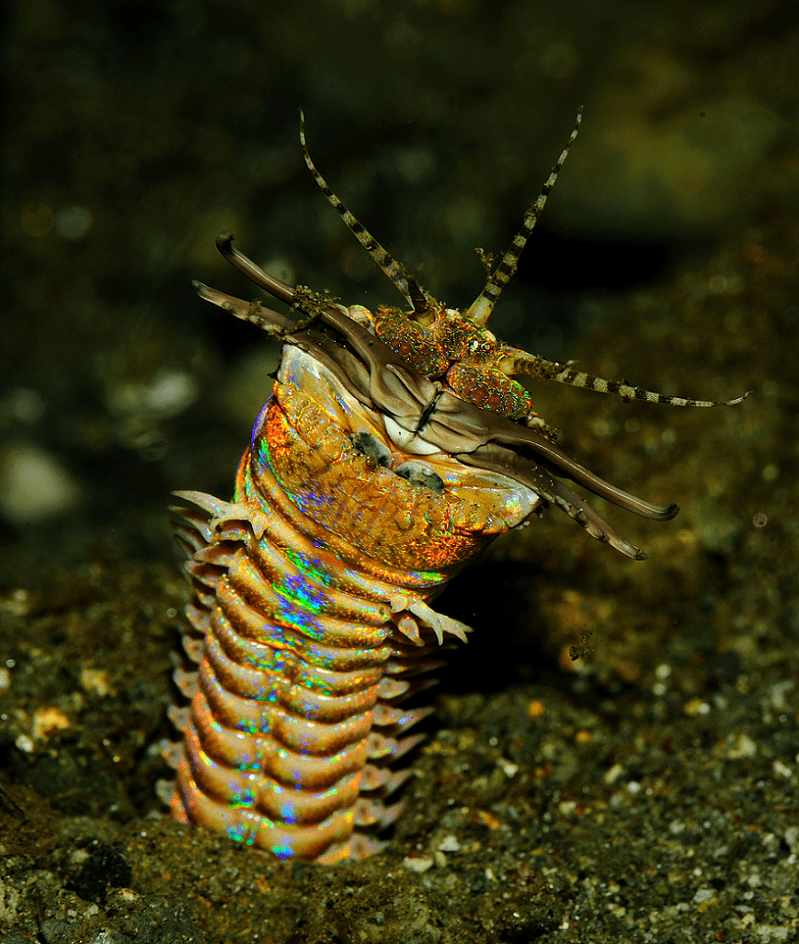Bobbit Worm Facts
- Perhaps most notably, the term Bobbit Worm now serves as the colloquially- based common name for a truly incredible animal with a complex scientific name. That name is the Eunice aphroditois. In point of fact, its name derives from a rather notorious event that occurred in the United States, in North America, in the mid-1990’s.
- Furthermore, this worm also currently remains one of the most unique and disturbing predators found in any ocean. The fascinating, though somewhat disturbing, animal officially classifies as an aquatic predatory polychaete worm. It represents only one of more than 10,000 members of its class, however.
- In addition, this remarkable creature also remains extremely rare, and thus rarely encountered. Therefore, as a result, very little information appears certain about the biology of the species. One fact stands out, however. That’s the incredible speed it displays when attacking its prey. When it does, it strikes with such velocity that it often cuts its prey in half.
Related Articles
Bobbit Worm Physical Description
First of all, the astonishing Bobbit Worm represents an extremely large species of aquatic worm. Individuals typically attain an average length of roughly 39 in (1 m). But, individual specimens of the species occasionally grow to lengths of as much as 10 ft (3 m).
In addition, the species also displays rather bright colors, most commonly including shades of bright purple. Additionally, it displays a total of five comparatively long antennae. These features serve it quite well in the detection of prey, while it remains hidden.
This truly amazing animal also possesses a rather hard exoskeleton, covering the great majority of its body. Despite its relatively great length, its width rarely exceeds 1 in (2.5 cm). Therefore, the vast majority of individuals studied have a decidedly slim shape.
However, its best-known physical feature obviously remains its incredibly powerful mandibles. These extremely over-powered features the sea-dwelling terror uses with amazing efficiency. As a result of this ability, Nature saw no reason to equip it with any type of venom.
- Kingdom: Animalia
- Phylum: Annelida
- Class: Polychaeta
- Order: Einicida
- Family: Eunicidae
- Genus: Eunice
- Species: E. aphroditois
Bobbit Worm Distribution, Habitat, and Ecology
It bears mentioning that the incredible Bobbit Worm appears to make its home in most tropical waters. However, it does have its preferred regions. As a result, the small but impressive creature appears to be most common in the Indo-Pacific and Atlantic Oceans.
Furthermore, it also appears to prefer to inhabit the sand and gravel of the floor of the ocean. It will also inhabit various coral reefs on occasion. There, the predator buries itself in the sand, with only its antennae protruding, awaiting the arrival of its prey.
Though technically omnivorous, it nevertheless prefers to hunt its prey as an ambush predator. In this, it has the same habits as the Happy Face Spider and Spiny Bush Viper. Once it has its prey, it typically pulls it beneath the sand or into a burrow.
Finally, researchers currently possess no definite knowledge concerning the reproductive habits of the Bobbit Worm. Research into the animal understandably continues. But, studies have shown evidence indicates that the creature likely possesses a relatively long lifespan.
Species Sharing Its Range
Check out our other articles on 8 Geological Wonders of North America, Crowned Eagle, Eye of the Sahara, Giant Hogweed, Eastern Diamondback Rattlesnake, Island Marble

